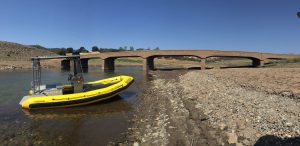Dr. Jay Lund, director of the UC Davis Center for Watershed Sciences, is the godfather of research on the Sacramento-San Joaquin Delta. When he says it took John Sutter eight days to wind his way from San Francisco Bay through the Delta to find the narrow Sacramento River in 1839, you can bet that’s the truth. Not until 1913 was the mouth of the river dredged to make it a mile wide. Grizzly bears roamed the wildness, feasting on an abundance of native fish, until they were hunted to local extinction. Today in the Delta, the largest estuary on the west coast of North America, only remnants remain of the natural landscape before it was irreversibly altered at the hands of people.
The Delta is a system of canals. In places, you can stand on a man-made levee with high water on one side and sunken land on the other. For 7,000 years, sediment accumulated to form deposits of organically-rich peat soil, but the last 170 years of farming have undone this natural process. About 2,300 dump trucks worth of soil is lost per day, oxidized as carbon dioxide and all told, about half of the Delta’s soil material is now gone, says Curt Schmutte, a civil engineer who specializes in Delta issues. We named plots of land in the Delta “islands,” but scientists refer to them — the majority below sea level — as “holes.”
I’m with a tour group on a hot September afternoon, and we hold onto our hats and brace ourselves as the boat tears through the water at 40 miles per hour, past invasive water hyacinth, tules, fishermen, houseboats, farmland and cattle. The Delta accumulates water from California’s largest watershed and acts as the hub of the state’s water supply system, linking water from the north to the two biggest water projects, which play a major role in sustaining the world’s sixth largest economy and much of its industry, agriculture and 39 million people.
But the Delta exists under unrelenting pressure: from land-use change, population growth, nutrient pollution from wastewater treatment plants, earthquakes, agriculture, sea-level rise and more. Even with money, there’s no silver bullet to fix this ecosystem — but there are plenty of battling sides. “It’s like a game of chicken,” Lund says. “How do you break a game of chicken?”
Was it Mark Twain who proclaimed, “Whiskey is for drinking; water is for fighting over”? When it comes to this natural resource, our state is rife with conflict. And, perhaps, in the Sacramento region, open to resolution. While the state is all-consumed with water wars, the region’s efforts toward collaboration are easy to overlook. The best example is the landmark Water Forum Agreement, which 22 water agencies from Sacramento, El Dorado and Placer counties signed in 2000 to balance the environmental and human needs of the lower American River.
Now, water agencies have joined together again to launch the River Arc Project. Proponents say the project has the potential for a groundbreaking impact. It would help recharge groundwater through a management practice called “conjunctive use.” It would also allow for ongoing growth by creating an additional source of water to lessen demand on the lower American River and Folsom Lake, which already provide drinking water to 1 million residents, says Andy Fecko, director of resource development at Placer County Water Agency. “What’s unique about our region is we’re doing this before we have a crisis.”
More at ComstockMag.com >>>

